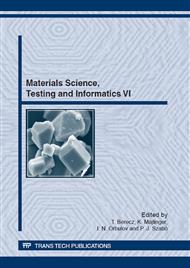[1]
A. Hensel, T. Spittel Kraft- und Arbeitsbedarf bildsamer Formgebungsverfahren; VEB Deutscher Verlag für Grundstoffindustrie: Leipzig, 1978, pp.33-232.
Google Scholar
[2]
G. Drossel, S. Friedrich, W. Huppatz, C. Kammer, W. Lehnert, O. Liesenberg, M. Paul, K. Schemme, Aluminium-Taschenbuch, 15th ed.; Aluminium-Zentrale e. V.: Düsseldorf, 1999; pp.130-136.
Google Scholar
[3]
A. Geleji Die Kräfte und der Kraftbedarf bei der Formgebung im bildsamen Zustande der Metalle, Mitteilungen der berg- und hüttenmänn. Abt. 14 ().
DOI: 10.1515/9783112527443-095
Google Scholar
[4]
P. W. Whitton The calculation of drawing forces and die pressure in wire drawing, J. Inst. Metals 85 (1958) 417.
Google Scholar
[5]
H. Lippmann, O. Mahrenholtz Plastomechanik der Umformung metallischer Werkstoffe, Springer-Verlag: Berlin, (1967).
DOI: 10.1007/978-3-642-87884-8
Google Scholar
[6]
B. Avitzur Analysis of wire drawing and extrusion through conical dies of large cone angle, Trans. ASME. J. Eng. Ind. 86 (1964) 305–316.
DOI: 10.1115/1.3670547
Google Scholar
[7]
G. Sachs Zeitschrift für Mathematik und Mechanik 7 (1927) 235.
Google Scholar
[8]
M. Voith Kohógéptan III. -A csőgyártás és húzás gépi berendezései (Theory of Metallurgical Machines III. ); Tankönyvkiadó: Budapest, Hungary, 1970, pp.11-21.
Google Scholar
[9]
F. Körber, A. Eichinger Die grundlagen der bildsamen Formgebung, Mitt. K. Wilh. Inst. Eisenforsch 22, 395 (1940) 57-80.
Google Scholar
[10]
D. J. Celentano, M. A. Palacios, E. N. Rojas, M. A. Cruchaga, A. A. Artigas, A. E. Monsalve, Simulation and experimental validation of multiple-step wire drawing process, Finite Elements in Analysis and Design 45 (2009) 163–180.
DOI: 10.1016/j.finel.2008.09.001
Google Scholar
[11]
S. A. Geleji DHCF 17 típusú húzógép techológiai paramétereinek elméleti és kísérleti vizsgálata (Theoretical and experimental study of the technological parameters of the DHCF 17 drawing machine); project report, University of Heavy Industry, Hungary, (1966).
Google Scholar
[12]
S.K. Lee, S.B. Lee, B.M. Kim Process design of multi-stage wet wire drawing speed for 0. 72wt% C steel wire, Journal of Materials Processing Technology 210 (2010) 776–783.
DOI: 10.1016/j.jmatprotec.2010.01.007
Google Scholar
[13]
W. Linicus, G. Sachs Versuche über die Eigenschaften gezogener Drähte und den Kraftbedarf beim Drathziehen, Mitteilungen der deutsche Materialprüfung. Zeitschrift für Metallkunde 23 (1931) 205-210.
DOI: 10.1007/978-3-642-99086-1_3
Google Scholar
[14]
L. Nistor, M. Ancău Creşterea productivităţii în trefilarea multiplă a sărmelor prin optimizarea numărului de trefilări folosite, Metalurgia 59 (2007) 5-13.
Google Scholar
[15]
E. Siebel Der derzeitige Stand der Erkenntnisse über die mechanischen Vorgange beim Drahtziehen, Stahl u. Eisen 66/67 (1947) 171-180.
Google Scholar
[16]
E. Kiss Képlékeny alakítás (Metalforming); Tankönyvkiadó: Budapest, 1987; pp.459-518.
Google Scholar
[17]
M.T. Hillery, V.J. McCabe Wire drawing at elevated temperatures using different die materials and lubricants, Journal of Materials Processing Technology 55 (1995) 53-57.
DOI: 10.1016/0924-0136(95)01784-4
Google Scholar


